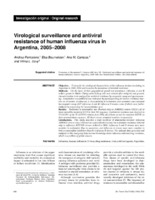Por favor, use este identificador para citar o enlazar este ítem:
http://sgc.anlis.gob.ar/handle/123456789/290| Título : | Virological surveillance and antiviral resistance of human influenza virus in Argentina, 2005-2008 | Otros títulos : | Vigilancia virológica y resistencia a los antivíricos del virus de la gripe humana en la Argentina, 2005–2008 | Autor : | Pontoriero, Andrea Baumeister, Elsa Campos, Ana Savy, Vilma L. |
Palabras clave : | Virus de la Influenza A;Resistencia a Medicamentos;Antivirales;Argentina | Fecha de publicación : | 2011 | Editorial : | World Health Organization | Journal: | Revista panamericana de salud publica = Pan American journal of public health | Resumen : | Objective. To describe the virological characteristics of the influenza strains circulating in Argentina in 2005–2008 and to assess the prevalence of antiviral resistance. Methods. On the basis of their geographical spread and prevalence, influenza A and B isolates grown in Madin–Darbycanine kidney cells were selected after antigenic and genomic characterization to be analyzed for antiviral resistance by enzymatic assay and yrosequencing. Amantadine susceptibility was evaluated by pyrosequencing for known resistance markers on 45 strains of influenza A. Susceptibility to oseltamivir and zanamivir was evaluated by enzymatic assay of 67 influenza A and 46 influenza B strains, some of which were further analyzed by sequencing the neuraminidase gene. Results. Resistance to amantadine was observed only on A(H3N2) strains (29/33); all of them carried the mutation S31N in their M2 sequence. Oseltamivir resistance was observed in 12 (34.3%) of the 35 A(H1N1) strains from 2008; all of them carried the mutation H275Y in their neuraminidase sequence. All these viruses remained sensitive to zanamivir. Conclusions. This study describes a high incidence of amantadineresistant influenza A(H3N2) viruses since 2006 and an unprecedented increase in oseltamivir resistance detected only in influenza A(H1N1) viruses isolated in 2008. Influenza A and B viruses were more sensitive to oseltamivir than to zanamivir, and influenza A viruses were more sensitive to both neuraminidase inhibitors than the influenza B viruses. The national data generated and analyzed in this study may help increase knowledge about influenza antiviral drug resistance, which is a problem of global concern. |
Descripción : | Fil: Pontoriero, Andrea. ANLIS Dr.C.G.Malbrán. Instituto Nacional de Enfermedades Infecciosas. Departamento de Virología; Argentina. Fil: Baumeister, Elsa. ANLIS Dr.C.G.Malbrán. Instituto Nacional de Enfermedades Infecciosas. Departamento de Virología; Argentina. Fil: Campos, Ana. ANLIS Dr.C.G.Malbrán. Instituto Nacional de Enfermedades Infecciosas. Departamento de Virología; Argentina. Fil: Savy, Vilma L. ANLIS Dr.C.G.Malbrán. Instituto Nacional de Enfermedades Infecciosas. Departamento de Virología; Argentina. |
URI : | http://sgc.anlis.gob.ar/handle/123456789/290 http://www.scielosp.org/pdf/rpsp/v30n6/a23v30n6.pdf |
ISSN : | 1020-4989 | Derechos: | info:eu-repo/semantics/openAccess Creative Commons Attribution 3.0 International License |
| Aparece en las colecciones: | snrd Publicaciones INEI |
Ficheros en este ítem:
| Fichero | Descripción | Tamaño | Formato | |
|---|---|---|---|---|
| PanAmericanJournalofPublicHealth,RevistaPanamericanadeSaludPública,2011,30(6),634–640.pdf | Artículo en inglés | 194.79 kB | Adobe PDF |  Visualizar/Abrir |
Visualizaciones de página(s)
203
comprobado en 16-dic-2025
Descarga(s)
80
comprobado en 16-dic-2025
Google ScholarTM
Consultar
Este ítem está sujeto a una licencia Creative Commons Licencia Creative Commons


